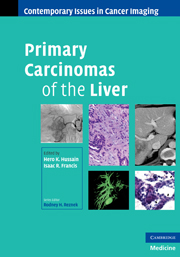Book contents
- Frontmatter
- Contents
- Contributors
- Series foreword
- Preface to Primary Carcinomas of the Liver
- 1 Epidemiology of hepatocellular carcinoma and cholangiocarcinoma
- 2 Surveillance and screening for hepatocellular carcinoma
- 3 Pathology of hepatocellular carcinoma, cholangiocarcinoma, and combined hepatocellular-cholangiocarcinoma
- 4 Radiological diagnosis of hepatocellular carcinoma
- 5 Staging of hepatocellular carcinoma
- 6 Surgical treatment of hepatocellular carcinoma: resection and transplantation
- 7 Non-surgical treatment of hepatocellular carcinoma
- 8 Radiological identification of residual and recurrent hepatocellular carcinoma
- 9 Radiological diagnosis of cholangiocarcinoma
- 10 Staging of cholangiocarcinoma
- 11 Treatment of cholangiocarcinoma
- 11.1 Surgical treatment: resection and transplantation
- 11.2 Non-surgical treatment
- 12 Uncommon hepatic tumors
- Index
- Color plates
- References
11.1 - Surgical treatment: resection and transplantation
from 11 - Treatment of cholangiocarcinoma
Published online by Cambridge University Press: 04 August 2010
- Frontmatter
- Contents
- Contributors
- Series foreword
- Preface to Primary Carcinomas of the Liver
- 1 Epidemiology of hepatocellular carcinoma and cholangiocarcinoma
- 2 Surveillance and screening for hepatocellular carcinoma
- 3 Pathology of hepatocellular carcinoma, cholangiocarcinoma, and combined hepatocellular-cholangiocarcinoma
- 4 Radiological diagnosis of hepatocellular carcinoma
- 5 Staging of hepatocellular carcinoma
- 6 Surgical treatment of hepatocellular carcinoma: resection and transplantation
- 7 Non-surgical treatment of hepatocellular carcinoma
- 8 Radiological identification of residual and recurrent hepatocellular carcinoma
- 9 Radiological diagnosis of cholangiocarcinoma
- 10 Staging of cholangiocarcinoma
- 11 Treatment of cholangiocarcinoma
- 11.1 Surgical treatment: resection and transplantation
- 11.2 Non-surgical treatment
- 12 Uncommon hepatic tumors
- Index
- Color plates
- References
Summary
Cholangiocarcinoma can present anywhere along the biliary tree. Clinical presentation, preoperative evaluation, and treatment are dependent on the anatomic location of the tumor. Cholangiocarcinomas are divided into those that arise in the extrahepatic and those that arise in the intrahepatic bile ducts. Cholangiocarcinomas originating in the extrahepatic bile ducts are categorized as distal, mid, and proximal (hilar). Distal tumors are those lying in the retroduodenal and intrapancreatic bile duct. Mid bile duct tumors lie below the right and left bile-duct confluence but above the retroduodenal common bile duct. Proximal bile-duct tumors lie at or above the right–left bile-duct confluence.
Preoperative assessment
Extrahepatic cholangiocarcinoma
Patients with extrahepatic cholangiocarcinoma most frequently present with jaundice but have often had more non-specific accompanying symptoms for a few weeks to months prior to the onset of jaundice. Those additional symptoms include pruritus, mild abdominal pain, anorexia, and weight loss. Infrequently, asymptomatic patients with extrahepatic cholangiocarcinoma will be diagnosed because of an unexplained rise in serum alkaline phosphatase or bilirubin or because an imaging study done to evaluate for another condition demonstrates dilated bile ducts. The age at presentation is most frequently 60 years or greater, but younger patients, especially those with ulcerative colitis, primary sclerosing cholangitis, or choledochal cyst, may present with cholangiocarcinoma.
Initial laboratory assessment of patients with jaundice or with dilated bile ducts should include liver functions: total bilirubin, fractionated bilirubin, alkaline phosphatase, aspartate transaminase (AST), alanine transaminase (ALT), serum albumin; complete blood count, including platelet count; prothrombin time and partial thromboplastin time; tumor markers, including carcinoembryonic antigen (CEA), cancer antigen (CA)19–9, and alpha-fetoprotein (AFP); blood urea nitrogen (BUN) and creatinine; and hepatitis serologies, including hepatitis A antibody, hepatitis B surface antigen and antibody, hepatitis B core antibodies, and hepatitis C antibody.
- Type
- Chapter
- Information
- Primary Carcinomas of the Liver , pp. 177 - 194Publisher: Cambridge University PressPrint publication year: 2009

